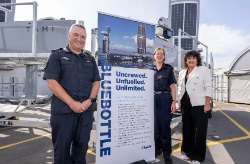Multiple risks ignored in proposed new airport terminal
Multiple risks ignored in proposed new airport terminal –
New Plymouth
From: Climate Justice Taranaki Inc.
Date: 15 May 2017
The New Plymouth District Council proposes to borrow close to $30 million on a new, larger airport terminal with a unique cultural design. Climate Justice Taranaki Inc. raises serious questions about the risk assessment and business case behind the proposal.
“I was gobsmacked when I arrived at the
airport, and there was a huge drill rig right there in front
of the café. It was last September. It was apparently there
to plug old wells.
There is no relief in thinking that the airport wells are not producing and are therefore safe. In fact, the likelihood of an abandoned well leaking increases over time. The Parliamentary Commissioner for the Environment has made it clear that once a well is abandoned and ‘signed off’, any leaks or other problems become the responsibility of the landowner,” said Catherine Cheung, Researcher of Climate Justice Taranaki Inc..
The danger of oil and gas activities, whether it
is current or historic, is real. Just last month, a Colorado home was blasted to the ground,
killing two people. The cause of the explosion was a gas
leak from a cut pipeline that’s connected to an old gas
well that was recently restarted.
“Did Council
take such risks and liability into account when conducting
the risk analysis for the new airport terminal? What if an
oil company decides to resume drilling, fracking, production
or injection activities onsite? Is Council certain that the
health and safety risks associated with the increase in
aviation and passenger traffic that they hope will follow,
are justified or manageable?” Cheung asked.
Currently in the New Plymouth District Plan, there are no
rules specifying the minimum separation distances required
between hazardous facilities like wellsites and sensitive
landuse like schools and airports where people congregate.
The South Taranaki District Council, under pressure
from the oil companies, dropped all the specified setback
requirements, despite Taranaki Energy Watch’s expert
witnesses arguing strongly for minimum setbacks based on
analysis of effects and risks to human health, property and
the environment.
“We are gutted that NPDC has
joined the oil companies and Stratford District Council in
opposition to Taranaki Energy Watch’s appeal on STDC’s
decisions. We expect Council to care for our health and
safety, not to ally with oil companies when considering
rules that could potentially jeopardise people’s
lives,” Cheung said.
There are other risks that
Council must evaluate when considering the airport expansion
– the impacts of climate change and the associated extreme
weather events and sea level rise.
“There is no
doubt that coastal hazards are increasing over time. The
Environment Commissioner has warned that even a small amount
of sea level rise will substantially
exacerbate the costs of flooding and storm surges. When
risks become uneconomic, an asset like the airport could
become ‘uninsurable’. Council’s business
case on the proposed airport expansion totally ignores
climate change and the financial risks and liability
associated with it,” Cheung concluded.
Climate Justice Taranaki’s submission to NPDC re the proposed new airport terminal is here: https://climatejusticetaranaki.files.wordpress.com/2013/03/cjt-submission-on-npdc-annual-plan-re-airport-expansion-and-water-rates-final.pdf


 Gordon Campbell: On The Left’s Electability Crisis, And The Abundance Ecotopia
Gordon Campbell: On The Left’s Electability Crisis, And The Abundance Ecotopia NZ Government: Stay Safe On Our Roads This Easter
NZ Government: Stay Safe On Our Roads This Easter YWCA: Global Push Back Against Gender Equality A Growing Crisis In Aotearoa
YWCA: Global Push Back Against Gender Equality A Growing Crisis In Aotearoa Te Pāti Māori: Ngarewa-Packer - Fast-Tracking Seabed Mining Ignores Māori Opposition And Environmental Precedent
Te Pāti Māori: Ngarewa-Packer - Fast-Tracking Seabed Mining Ignores Māori Opposition And Environmental Precedent New Zealand Defence Force: Defence And Customs Strengthen Maritime Security With Uncrewed Surface Vessels
New Zealand Defence Force: Defence And Customs Strengthen Maritime Security With Uncrewed Surface Vessels SPCA: Huge Win With New Dog Tethering Regulations
SPCA: Huge Win With New Dog Tethering Regulations Community Housing Aotearoa: Ngā Wharerau o Aotearoa Says New Partnership Model Helping Ensure Right To A Decent Home Is Realised
Community Housing Aotearoa: Ngā Wharerau o Aotearoa Says New Partnership Model Helping Ensure Right To A Decent Home Is Realised


